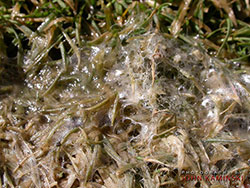Some bluegrass lawns in Colorado develop symptoms of gray snow mold, a fungal turf disease. The injury appears as circular patches of matted, discolored turf scattered throughout the lawn.
The disease develops when snow falls on unfrozen turf and remains for long periods of time. Snow mold fungi thrive under snow cover in temperatures just above freezing.  Snow mold symptoms may appear to a greater extent where snow was shoveled onto turf or drifts formed.
Snow mold symptoms may appear to a greater extent where snow was shoveled onto turf or drifts formed.
As snow recedes, circular patches of light yellow, straw or brown-colored turf begin to appear. The grass blades in these patches are matted and may be covered with gray or white webbing. As the grass dries, the webbing disappears and patches crust-over. However, cool, wet spring weather may prolong fungal activity. Once temperatures regularly exceed 45 degrees or the turf dries out, snow mold activity ceases.
As temperatures warm, the turf begins its recovery with new leaf development. Affected turf areas may be slower to green up.
To manage snow mold, homeowners can rake the patches to break up the crust and allow the turf to dry out. A light fertilizer application may be made in the spring. Fungicide applications are preventive only and must be applied in fall.
Environmental conditions must be right for snow mold to develop – long-lasting snow cover is not common in the Front Range and Plains of Colorado. It is unlikely gray snow mold will be a problem on bluegrass during most years.



